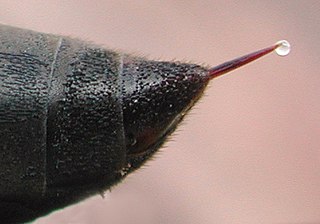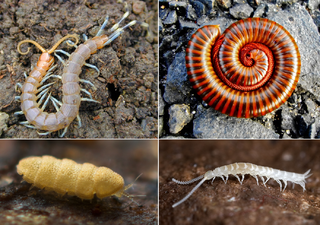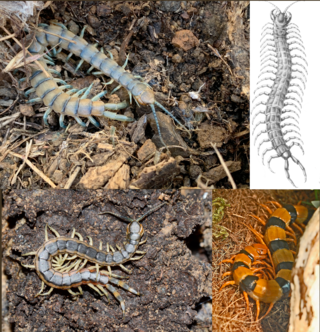
Venom or zootoxin is a type of toxin produced by an animal that is actively delivered through a wound by means of a bite, sting, or similar action. The toxin is delivered through a specially evolved venom apparatus, such as fangs or a stinger, in a process called envenomation. Venom is often distinguished from poison, which is a toxin that is passively delivered by being ingested, inhaled, or absorbed through the skin, and toxungen, which is actively transferred to the external surface of another animal via a physical delivery mechanism.

Centipedes are predatory arthropods belonging to the class Chilopoda of the subphylum Myriapoda, an arthropod group which includes millipedes and other multi-legged animals. Centipedes are elongated segmented (metameric) creatures with one pair of legs per body segment. All centipedes are venomous and can inflict painful bites, injecting their venom through pincer-like appendages known as forcipules. Despite the name, no centipede has exactly 100 pairs of legs; number of legs ranges from 15 pairs to 191 pairs, always an odd number. They are predominantly carnivorous.

Scutigera coleoptrata, also known as the house centipede, is a species of centipede that is typically yellowish-grey and has up to 15 pairs of long legs. Originating in the Mediterranean region, it has spread to other parts of the world, where it can live in human homes. It is an insectivore; it kills and eats other arthropods, such as insects and arachnids.

Myriapods are the members of subphylum Myriapoda, containing arthropods such as millipedes and centipedes. The group contains about 13,000 species, all of them terrestrial.

A stinger is a sharp organ found in various animals capable of injecting venom, usually by piercing the epidermis of another animal.

The Arizona bark scorpion is a small light brown scorpion common to the Sonoran Desert in the southwestern United States and northwestern Mexico. An adult male can reach 8 cm in length (3.14 inches), while a female is slightly smaller, with a maximum length of 7 cm (2.75 inches).

Scolopendra gigantea, also known as the Peruvian giant yellow-leg centipede or Amazonian giant centipede, is a centipede in the genus Scolopendra. It is the largest centipede species in the world, with a length exceeding 30 centimetres (12 in). Specimens may have 21 or 23 segments. It is found in various places throughout South America and the extreme south Caribbean, where it preys on a wide variety of animals, including other sizable arthropods, amphibians, mammals and reptiles.

The Chinese red-headed centipede, also known as the Chinese red head, is a centipede from East Asia and Australasia. It averages 20 cm (8 in) in length and lives in damp environments.

Hadrurus arizonensis, the giant desert hairy scorpion, giant hairy scorpion, or Arizona Desert hairy scorpion is a large scorpion found in North America.

The striped bark scorpion is an extremely common scorpion found throughout the midsection of the United States and northern Mexico. It is perhaps the most frequently encountered scorpion in the U.S.

Scolopendra subspinipes is a species of very large centipede found throughout southeastern Asia. One of the most widespread and common species in the genus Scolopendra, it is also found on virtually all land areas around and within the Indian Ocean, all of tropical and subtropical Asia from Russia to the islands of Malaysia and Indonesia, Australia, South and Central America, the Caribbean islands, and possibly parts of the southern United States, but how much of this range is natural and how much due to human introduction is unclear. With a wide geographic range and numerous color variations, the species is known by many common names, including jungle centipede, orange-legged centipede, Hawaiian centipede, and Vietnamese centipede.

Ethmostigmus rubripes, the giant centipede, is the largest Australian centipede. It has three subspecies, with substantial variation within each.

Scolopendra is a species-rich genus of large tropical centipedes of the family Scolopendridae.

Scolopendra polymorpha, the common desert centipede, tiger centipede, banded desert centipede, or Sonoran Desert centipede, is a centipede species found in western North America and the Hawaiian Islands.

A centipede bite is an injury resulting from the action of a centipede's forcipules, stinger-like appendages that pierce the skin and inject venom into the wound. Such a wound is not strictly speaking a bite, as the forcipules are a modified first pair of legs rather than true mouthparts. Clinically, the wound is viewed as a cutaneous condition characterized by paired hemorrhagic marks that form a chevron shape caused by the paired forcipules.

Grasshopper mice are rodents of the genus Onychomys, occurring in North America. They feed on insects and other arthropods.

Scolopendra morsitans, also known as the Tanzanian blue ringleg or red-headed centipede, is a species of centipede in the family Scolopendridae. S. morsitans is the type species for the genus Scolopendra.

Scolopendra viridicornis is a species of centipede in the family Scolopendridae which can be found within the Amazon rainforest, the type locality being in Brazil. Due to the geographic distribution of this species it is known as the Amazonian giant centipede.

Spooky toxin (SsTx) is a small peptide neurotoxin. It is found in the venom of Chinese red-headed centipedes, also known as golden head centipedes. It is originally composed of 76 amino acids, with a molecular weight of 6017.5 Daltons, but loses the first 23 residues and becomes 53 residues long. SsTx is currently thought to be unique to Scolopendra subspinipes mutilans.

Scolopendra dehaani, common name Giant Vietnamese centipede, is a large Scolopendrid centipede found across Mainland Southeast Asia. It is also found in India, Japan, Hong Kong, and the Andaman and Nicobar Islands.





















